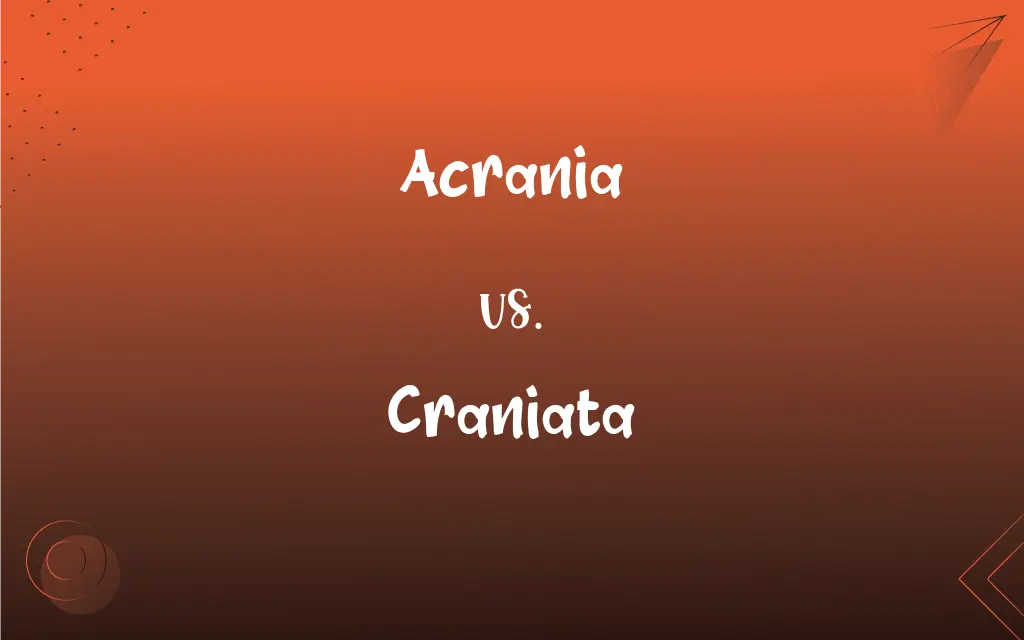Acrania vs. Craniata: What's the Difference?
Edited by Aimie Carlson || By Janet White || Updated on October 6, 2023
Acrania are animals lacking a skull, like lancelets. Craniata are animals with a skull, encompassing most vertebrates.

Key Differences
Acrania and Craniata are terms used in zoology to describe two distinct groups of animals based on the presence or absence of a skull. Acrania represents a small group of chordates that do not possess a skull. One of the most commonly known members of the Acrania group is the lancelet, a tiny marine animal that provides insight into the evolutionary stages of early chordates.
On the other hand, Craniata, as the name suggests, comprises animals that possess a well-defined skull. This group is more diverse and includes almost all vertebrates such as mammals, birds, reptiles, amphibians, and many fish. The presence of a skull in Craniata provides protection for the brain and sensory organs, indicating a higher degree of evolutionary complexity than Acrania.
It's interesting to note that while Acrania is a primitive group and lacks many features present in more evolved organisms, they are still considered chordates. This means they share some common features with Craniata, like having a notochord at some stage in their life cycle. However, the divergence between Acrania and Craniata showcases the different evolutionary paths these organisms took, with one leading to a more intricate and complex anatomical structure.
In studying the differences between Acrania and Craniata, scientists gain insight into the evolutionary history of chordates. By understanding the simpler structure of Acrania, researchers can infer the stages of development that led to the more advanced and diverse group of Craniata.
Comparison Chart
Skull Presence
Absent
Present
ADVERTISEMENT
Representative Species
Lancelets
Mammals, Birds, Fish, etc.
Evolutionary Complexity
Lower
Higher
Classification
Subphylum within Chordates
Subphylum within Chordates
Brain Protection
Lacks a protective structure
Skull provides protection
Acrania and Craniata Definitions
Acrania
Chordates lacking a skull.
Lancelets are a prime example of Acrania.
ADVERTISEMENT
Craniata
Organisms with bony or cartilaginous braincases.
Fish, despite their diversity, are all Craniata due to their skull presence.
Acrania
Marine organisms with a notochord but no skull.
Studying Acrania helps in understanding chordate evolution.
Craniata
Animals with a protective cranial cavity.
Birds, being Craniata, have skulls protecting their brains.
Acrania
Animals without a defined cranial cavity.
Acrania species have a simpler anatomy compared to vertebrates.
Craniata
Chordates possessing a skull.
Humans are a part of the Craniata group.
Acrania
Primitive chordates missing bony structures around the brain.
Acrania exhibit evolutionary traits of early chordates.
Craniata
Chordates distinct from Acrania due to their skull.
Craniata represents a significant leap in evolutionary complexity.
Acrania
The condition in humans where the cranial vault is absent.
Acrania is a severe congenital disorder.
Craniata
Vertebrates with a well-defined head structure.
The diversity of Craniata is vast, from reptiles to mammals.
Acrania
(physiology) Partial or total absence of the skull.
Craniata
Fishes; amphibians; reptiles; birds; mammals
Acrania
Partial or total absence of the skull.
Acrania
The lowest group of Vertebrata, including the amphioxus, in which no skull exists.
FAQs
What's the primary difference between Acrania and Craniata?
Acrania lacks a skull, while Craniata possesses one.
Which group showcases a higher evolutionary complexity?
Craniata, due to their skull and other advanced features.
Are lancelets considered vertebrates?
No, they are Acrania and lack the vertebral column.
Do Acrania have brains?
Yes, but they lack the protective skull around them.
Which group is more diverse, Acrania or Craniata?
Craniata is more diverse, including most vertebrates.
How do lancelets, a type of Acrania, protect their brain?
They lack a solid skull, so their brain isn't as protected as in Craniata.
Where can Acrania species like lancelets be found?
They are marine animals, often found in shallow waters.
Do Acrania have a notochord?
Yes, at some stage in their life cycle, similar to Craniata.
Are humans considered Craniata?
Yes, humans have a skull and are part of the Craniata group.
What's the significance of studying Acrania?
It provides insight into early chordate evolution.
Do all Craniata have a bony skull?
No, some have cartilaginous structures, but all have some form of protective skull.
Is the term "Acrania" ever used in a medical context?
Yes, it refers to a congenital disorder where the cranial vault is absent.
Are Craniata species more advanced than Acrania?
In terms of evolutionary complexity, yes, Craniata is more advanced.
How does the skull benefit the Craniata?
It provides protection for the brain and sensory organs.
Do all Craniata species have jaws?
No, not all; for example, jawless fish like lampreys are still Craniata.
Are all Craniata considered vertebrates?
Nearly all, but there are a few exceptions like hagfish.
Are birds part of the Craniata group?
Yes, birds possess a skull and are thus Craniata.
Does the absence of a skull in Acrania affect their sensory abilities?
They have simpler sensory structures compared to Craniata.
How do Acrania fit into the evolutionary tree?
They're considered primitive chordates and give insights into early chordate evolution.
Can the terms Acrania and Craniata be used interchangeably?
No, they represent distinct groups based on the presence or absence of a skull.
About Author
Written by
Janet WhiteJanet White has been an esteemed writer and blogger for Difference Wiki. Holding a Master's degree in Science and Medical Journalism from the prestigious Boston University, she has consistently demonstrated her expertise and passion for her field. When she's not immersed in her work, Janet relishes her time exercising, delving into a good book, and cherishing moments with friends and family.
Edited by
Aimie CarlsonAimie Carlson, holding a master's degree in English literature, is a fervent English language enthusiast. She lends her writing talents to Difference Wiki, a prominent website that specializes in comparisons, offering readers insightful analyses that both captivate and inform.































































